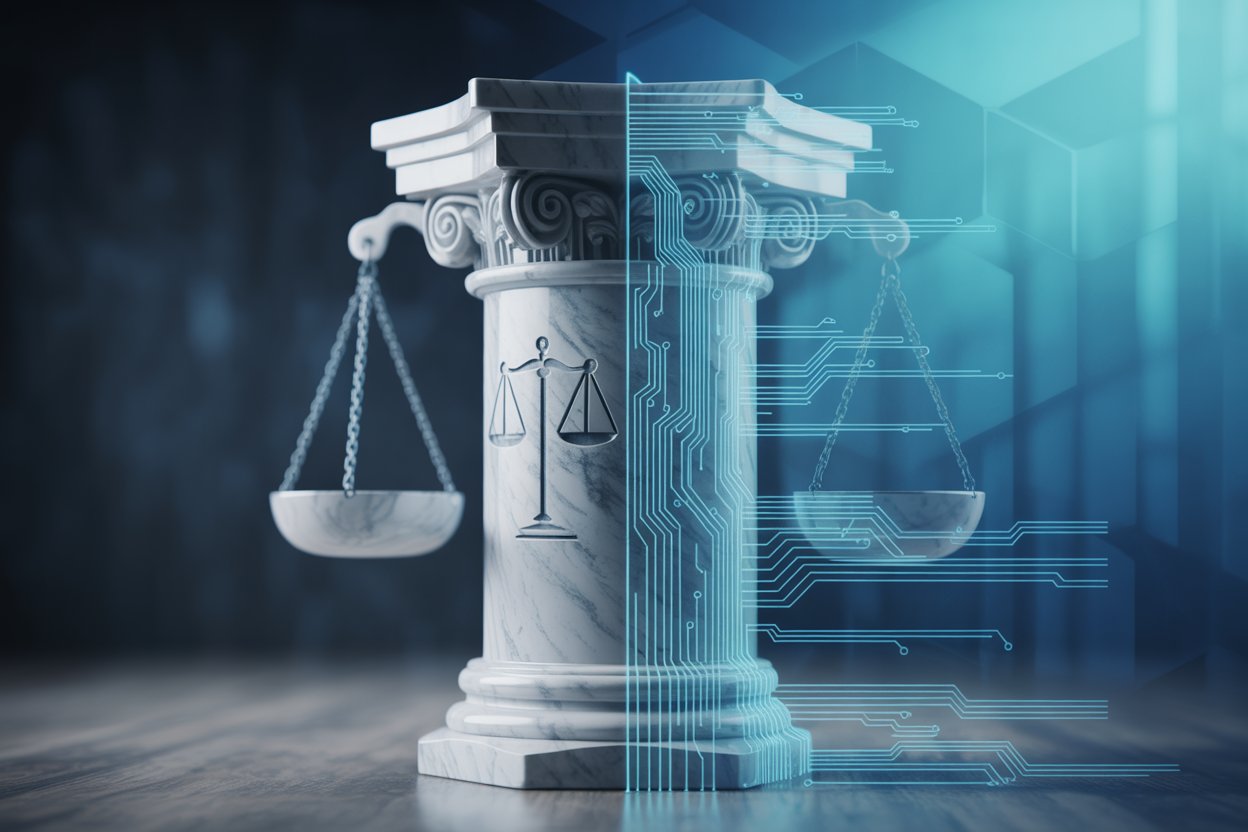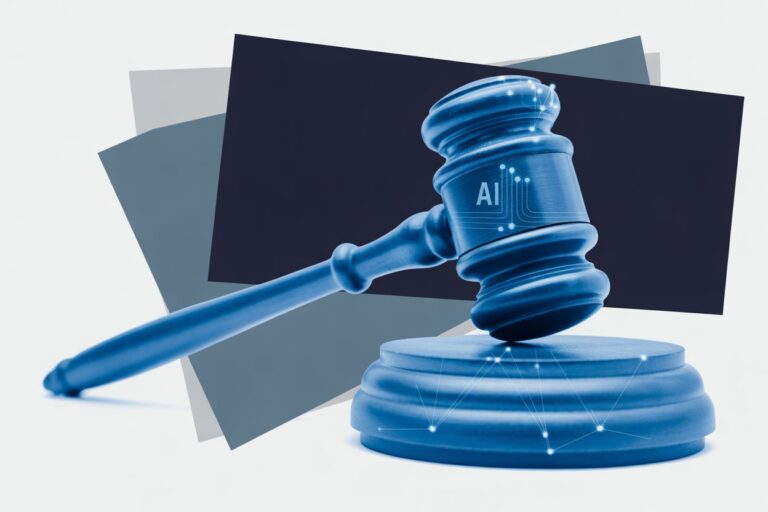Implementing AI in Law: A Practical Framework for Compliance, Governance, and Risk Management
A Practical White Paper for Safe, Compliant, and Effective AI Use in Legal Practice
Disclaimer
Each firm’s needs will vary by practice area and jurisdiction. This guide is intended as a practical starting point to help law firms implement AI safely and responsibly. It is not a one-size-fits-all policy but a general framework of best practices and governance principles for AI use in legal practice. It’s geared primarily for lawyers in the United States and Canada.
Introduction: Why AI Governance Can No Longer Wait
Artificial intelligence is reshaping how legal work gets done. It drafts contracts, summarizes discovery, and automates document review. Firms that delay integration risk losing ground to faster, more efficient competitors. But rushing forward without safeguards creates equal risk: liability, sanctions, and reputational damage.
This framework provides a roadmap for adopting AI responsibly. It is designed to help firms balance innovation with the professional duties that have always defined legal practice. The steps that follow are practical, immediate, and designed to keep lawyers in control, not their algorithms.
1. Understanding Insurance Coverage Before You Need It
Most firms assume existing malpractice insurance covers AI-related errors. That assumption is dangerous. Many E&O and malpractice policies were written before generative AI existed and now include ambiguous or exclusionary language.
Start by reviewing your policies with your broker. Ask explicit questions about whether your coverage extends to:
- AI-generated hallucinations or fabricated citations
- Vendor or platform errors
- Data breaches involving AI tools
- Claims tied to algorithmic bias or faulty automation
If your policy is silent on AI, that silence creates exposure. The insurance industry refers to this as “silent AI” coverage, echoing the earlier “silent cyber” problem when insurers discovered hidden liabilities for digital breaches.
Some carriers now offer AI-specific endorsements or standalone policies, though uptake remains limited. Expect detailed due diligence. Insurers will want to see documentation of which AI tools you use, how you supervise their outputs, and what governance protocols are in place.
Document every conversation with your insurer and keep written confirmation of what is and is not covered. If your insurer cannot answer directly, that itself signals risk.
Finally, build a sanctions response plan before you need one. If a court sanctions your firm for AI misuse, you should already know how to notify clients, coordinate with your insurer, and remediate the issue. Proactive planning demonstrates diligence to regulators and insurers alike.
Further reading: Does Your Law Firm’s E&O Insurance Cover AI Mistakes? Don’t Be So Sure
Bar associations and courts are moving faster than many firms realize. The ABA’s Formal Opinion 512 sets a clear baseline: lawyers must understand the tools they use. That includes both their capabilities and their limitations. You do not need to be a data scientist, but you cannot plead ignorance when an AI system produces flawed work under your name.
Create a centralized repository of jurisdiction-specific bar opinions and court orders related to AI. Assign someone to monitor updates and circulate summaries to practice groups. Courts like the Northern District of Texas already require lawyers to certify that AI outputs were verified by a human. Expect more jurisdictions to follow.
Some states require explicit disclosure when AI is used in filings, while others leave disclosure to professional discretion. Develop standardized certification templates for filings where required. Never discover a disclosure rule after you have filed a brief.
International rules add further complexity. The EU’s AI Act classifies legal-sector AI as “high-risk” and mandates transparency, documentation, and human oversight. If your firm serves EU clients, those obligations can apply even if you are based elsewhere, similar to GDPR.
The safest position is simple: track evolving rules, document your compliance, and verify every AI output before submission or client delivery.
3. Protecting Privilege and Client Confidentiality
Attorney-client privilege cannot be compromised by convenience. When you use AI, ensure the platform qualifies as a service provider under privilege rules.
Ask one key question: can the vendor access, retain, or train on client data? If yes, that tool cannot be used for confidential matters. Consumer tools like free ChatGPT versions often reuse data for training, which violates Rule 1.6 confidentiality standards.
Always choose enterprise-grade tools or private instances that guarantee no data retention or cross-use. Include those guarantees in your contract.
Segmentation is also essential. Never use a single AI workspace for multiple clients or opposing parties. Establish ethical walls and restrict access to practice-specific systems. This prevents cross-pollination of client information and inadvertent conflicts.
Work product protection deserves the same attention. When AI assists in developing strategy or analysis, maintain documentation showing that it acted as a supervised assistant, not a decision-maker. Courts will be more inclined to uphold work product protection if you can demonstrate human control throughout.
4. Establishing Governance and Accountability
AI without governance invites chaos. Someone in your firm must own this domain, whether an AI officer, a technology committee, or a managing partner in smaller practices.
Start with a written AI governance policy defining:
- Approved tools and use cases
- Access permissions and supervisory review
- Required documentation and prompt logging
- Training requirements for users
Keep an inventory of every AI tool used, its vendor, its purpose, and who can access it. This database becomes essential during audits, insurer reviews, or client inquiries.
Review and update governance documents quarterly, or when new bar opinions or regulations appear. The pace of change means yesterday’s compliant workflow can become tomorrow’s liability.
Plan for continuity. Document not just what tools you use, but why decisions were made and how systems integrate into workflows. Governance must outlast the people who designed it.
5. Preparing for When Things Go Wrong
AI errors are inevitable. What matters is how you respond.
Establish an incident response plan covering hallucinations, data leaks, or incorrect analyses that reach clients or courts. Assign roles in advance: who investigates, who notifies clients, who contacts insurers, and who communicates externally.
Tier your response protocols. A citation error caught internally differs from a filed hallucination or breached dataset. Every incident, however minor, should be documented.
After every significant event, conduct a root-cause review. Ask what failed, how it was discovered, and what will prevent recurrence. Regulators and insurers expect to see post-incident learning, not reactive damage control.
When clients are affected, communicate transparently but carefully. Prompt disclosure and professionalism will protect relationships and credibility far better than silence or delay.
6. Choosing and Managing AI Vendors
AI vendors vary widely in quality, confidentiality, and risk posture. Conduct due diligence as you would for any critical professional service.
Look for vendors with SOC 2 or ISO 27001 certifications and documented encryption and access controls. Insist on written commitments not to train on your data. Specify retention limits and deletion rights in your contract.
Maintain version control records. If a dispute arises, you may need to show which model version generated the output and whether known bugs existed at the time.
Implement a formal vendor-approval process. No lawyer or practice group should independently adopt new AI tools without centralized review. Fragmented adoption creates unmanageable compliance gaps.
Further reading: How to Choose the Right AI Vendor for Your Law Firm: A Step-by-Step Buying Guide
7. Standardizing AI Integration Across Practice Areas
AI adoption should be systematic, not scattered. Map how AI supports each practice area and define approved use cases.
For example:
- In research, AI may identify relevant cases but all citations must be verified in traditional databases.
- In drafting, AI can generate templates or first drafts, but a lawyer must review before client delivery.
- In contract work, AI may redline documents but cannot approve terms.
Integrate AI tools directly with your case or document management systems to reduce copy-paste risks and accidental data leaks.
Create firm-wide prompt libraries and meta-prompt templates. Standardized prompts help maintain consistent tone, structure, and disclaimers while improving accuracy.
Define output standards: formatting, citation style, tone, and disclaimers so that every AI-assisted document meets firm expectations.
Further reading: How Lawyers Can Reduce AI Mistakes in Legal Work
8. Understanding Bias, Alignment, and Model Limitations
AI bias is not theoretical; it is measurable. Legal practitioners must recognize when models embed assumptions that distort analysis or compromise advocacy.
Train staff on bias awareness. Develop checklists for high-risk areas such as employment, immigration, and criminal defense. Encourage lawyers to question model phrasing and reasoning rather than accept outputs at face value.
Perform periodic audits of AI-generated work. Review samples for fairness, accuracy, and consistency. Maintain audit records to prove proactive oversight if questioned by clients or regulators.
Remember that hallucinations are only one failure type. More subtle risks such as logical inconsistencies, omitted exceptions, or misapplied precedents can be just as damaging. Verification must extend beyond citation checks to substantive reasoning.
Further reading:
- Built-In Bias: What Every Lawyer Needs to Know About AI’s Hidden Prejudices
- AI Alignment in Law: Making Sure the Machines Follow the Rules
9. Building a Training and Feedback Culture
Training is the foundation of safe AI adoption. Provide onboarding for every lawyer and staff member covering firm policy, ethical duties, and tool-specific use. Offer refresher courses as technology evolves.
Ensure equitable access to AI tools so all practice groups develop competency. Create open feedback channels where users can report issues or share successful workflows.
Institutionalize continuous improvement. Hold periodic reviews to update workflows based on feedback and incident data. Recognize and reward employees who identify risks early or develop better AI practices.
When compliance and innovation are part of performance expectations, governance becomes self-reinforcing rather than top-down.
10. Maintaining Documentation and Audit Trails
Every AI interaction that touches client work should leave a record. Maintain logs of prompts, model versions, reviewers, and approvals.
Archive these materials with the client file to demonstrate diligence and transparency. Track usage by user, tool, and matter for accountability.
Establish a centralized knowledge base for firm-wide AI lessons, best practices, and incident summaries. Over time, this archive becomes an internal guidebook for smarter, safer use.
AI efficiency raises difficult billing questions. If automation cuts a task from three hours to thirty minutes, charging for three hours is unethical.
Establish written billing policies clarifying how AI-assisted time is calculated. Some firms bill for actual time plus review; others move to flat-fee or value-based pricing. Choose one approach and apply it consistently.
Update engagement letters to include AI disclosure clauses explaining how the technology supports representation and what safeguards are in place. Clients should understand that AI complements human judgment, not replaces it.
Offer opt-out options for clients uncomfortable with AI use and document those discussions. Transparency protects trust and reduces complaint risk.
Further reading: Are Lawyers Still Worth Their Billable Hours When AI Can Do It Faster?
12. Applying AI to Marketing and Business Development
AI can supercharge content creation, but marketing rules still apply. Model Rule 7.1 prohibits false or misleading statements whether they come from a lawyer or a machine.
Verify all AI-generated marketing copy for factual accuracy and compliance with jurisdiction-specific rules. Avoid client-identifying details unless permission is obtained and confidentiality standards are met.
All external materials such as websites, proposals, newsletters, or social posts should pass human review before publication. Accuracy and tone remain the lawyer’s responsibility.
13. Commit to Continuous Evaluation and Improvement
AI compliance is never finished. Schedule annual audits to review accuracy, efficiency, vendors (AI software used) and adherence to policy. Measure performance not just in time saved but in quality, client satisfaction, and error reduction.
Use those findings to refine policies, update training, and retire underperforming tools. Document audit results and corrective actions.
Stay active in bar tech committees and industry groups. Collaboration across firms helps track regulatory trends and benchmark best practices.
Continuous review is the only way to stay ahead of technology that changes faster than regulation.
Building for the Future While Protecting the Present
AI will not replace lawyers, but it will redefine excellence in lawyering. The firms that thrive will treat AI governance as a form of professionalism, not bureaucracy.
Your firm’s framework should evolve with the tools you use and the clients you serve. Whether you are a solo practitioner or part of a multinational firm, the fundamentals remain the same: verify everything, protect privilege, document rigorously, and maintain human judgment at the center.
Delegation does not equal absolution. When AI fails, the lawyer remains accountable.
The technology will continue evolving, but responsibility never will.
My Take
There’s a tendency to see AI safety and efficiency as opposing goals where one os about restraint, the other about acceleration. In reality, they’re interdependent. The firms that plan, design, and implement AI with care will find that strong guardrails don’t slow innovation; they make it sustainable.
Every policy, workflow, and safeguard is an investment in reliability and trust. Firms that strike this balance early will quietly build a competitive edge: clients will reward precision, not just speed. Given how profoundly disruptive AI will be to legal practice, getting the framework right isn’t optional, it’s essential. Done right, it’s transformative. Done poorly, it can create more problems than it solves.
Further Reading:
- Does Your Law Firm’s E&O Insurance Cover AI Mistakes? Don’t Be So Sure
- How to Choose the Right AI Vendor for Your Law Firm: A Step-by-Step Buying Guide
- How Lawyers Can Reduce AI Mistakes in Legal Work
- AI Alignment in Law: Making Sure Machines Follow the Rules
- Built-In Bias: What Every Lawyer Needs to Know About AI’s Hidden Prejudices
- AI Alignment in Law: Making Sure the Machines Follow the Rules
- Are Lawyers Still Worth Their Billable Hours When AI Can Do It Faster?







